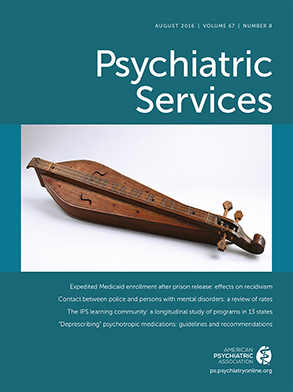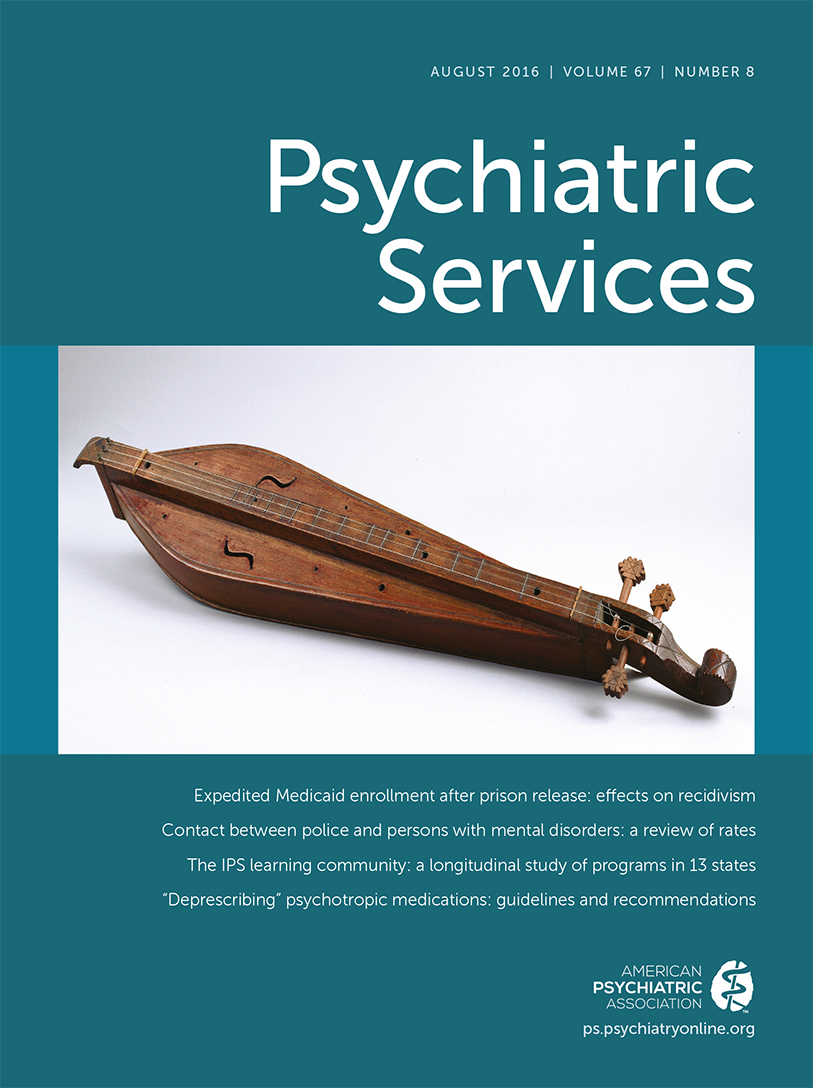A term now established in geriatric medicine, “deprescribing” has been defined as the systematic process of identifying and reducing or discontinuing drugs in instances in which existing or potential harms outweigh existing or potential benefits, taking into account the patient’s medical status, current level of functioning, and values and preferences (
1). The end goal of deprescribing is not necessarily the complete cessation of medications but rather their parsimonious use. Despite a scattered and disparate literature examining dose reduction or discontinuation of maintenance regimens (mostly notably antipsychotics and benzodiazepines), only recently in psychiatry’s history have general, structured, multidimensional approaches to medication discontinuation gathered momentum. Similarly, the field of cardiology is questioning the need for long-term medications by critically reexamining the evidence base and developing strategies for repeated risk-benefit analyses over time (
2).
Changing systems of care, lack of diagnostic and therapeutic precision, and a focus on symptomatic rather than functional outcomes have conspired with a relative lack of clinical evidence for (or experience with) medication discontinuation to increase rates of “prescribing inertia” and polypharmacy. Furthermore, many psychosocial factors, along with comorbid general medical and substance use disorders and the high importance given to the subjective experiences of patients, yield a particularly complex risk-benefit analysis for psychotropic medications. In this Open Forum, we describe how the process of deprescribing might be implemented in psychiatry, along with potential benefits, challenges, and future directions.
Indications for Deprescribing in Psychiatry
Changing Risk-Benefit Ratio
Biological, psychological, and social factors must align to produce a favorable risk-benefit ratio such that a medication regimen becomes established for a patient. Over time, this risk-benefit ratio can change, providing an indication for deprescribing. Certain adverse effects may develop only after longer-term use—for example, tardive dyskinesia with antipsychotics and renal impairment with lithium. Normal aging alters both the pharmacodynamics and the kinetics of medications, increasing vulnerability to side effects. Pregnancy, the development of general medical comorbidities, new medication interactions, and substance abuse raise similar issues. Psychological factors, such as patients’ choice, their understanding of illness and medication, and their coping strategies, may evolve over time, shifting their individual risk-benefit ratio. Social factors, such as geographical relocation, changes in financial and insurance status, and changes in religion, may prompt a reappraisal. The growth of the recovery movement and patient-centered care in psychiatry, including in pharmacological management, further necessitates the development of deprescribing skills.
Nonadherence and Treatment Alliance
Medication nonadherence is a significant and underappreciated issue in all of medicine. Abrupt, unsupervised discontinuation of certain medications risks withdrawal syndromes, rebound effects, and relapse of the underlying condition. Although research has attributed nonadherence to a range of pragmatic as well as treatment-specific factors, the lack of communication between the patient and the prescriber when the patient unilaterally decides to discontinue a medication raises questions of disconnect in the patient-prescriber relationship that are particularly pertinent in psychiatry. Perhaps by showing expertise in collaboration—and a willingness to collaborate—in regard to medication discontinuation from the outset, prescribers may reduce the chances of this disconnect and improve the alliance. Ambivalence about diagnosis and treatment is prevalent in psychiatry, attributable to the relative proximity of disorders to the core sense of self or to direct effects on insight and judgment. Due to the stigma associated with mental illness, which is often heightened by news media coverage, and an initial treatment focus on remission, a patient’s first impression of the psychiatrist may be that of a “pill pusher.” Alternatively, a patient may desire to please the prescriber through continued adherence, which might also generate conflict in regard to treatment. An initial discussion that gives equal weight to deprescribing (when appropriate) as well as prescribing may serve to counter such conflict.
Furthermore, guided by the patient’s preference, collaboration about a trial reduction or discontinuation of a medication, even if unsuccessful, might enhance the therapeutic relationship and the patient’s understanding of the illness and ownership of the medication regimen.
Polypharmacy
Practice guidelines recommend adequate trials of single medications before the addition of a second, but real-world practice differs (
3). Medicaid claims data have shown that psychotropic polypharmacy has risen consistently over the past two decades in various states (
4,
5). Although certain combinations of psychotropics have been shown to be beneficial in “treatment resistant” psychiatric disorders, the stability of the treatment-resistant label over time is unknown. In fact, Stahl and Grady (
6) found in their review that most practitioners do not try to discontinue one of the drugs after a combination proves beneficial, even though such discontinuation would establish the true need for the combination. Meanwhile, the risks, especially with increasing age and general medical comorbidities, render the risk-benefit ratio even more disproportionate.
Implementing Deprescribing in Psychiatry
It is imperative that every psychiatrist be able to provide an individualized risk-benefit analysis of each medication for a given patient at a given time point, keeping in mind general medical comorbidities and psychosocial circumstances. Woodward (
7) proposed the following five principles of deprescribing in geriatric medicine: review all current medications, identify medications to be targeted for reduction or cessation, plan a deprescribing regimen, plan in partnership with patients and caregivers, and provide frequent review and support. A review of more than ten studies of deprescribing found concordance in these five principles as the crucial elements of the process (
8).
Further key considerations for psychiatry may be the timing and context of the change, the patient’s alternative coping strategies, the meaning of the change for the patient, the strength of the treatment alliance, the level of risk, and whether the patient is receiving mandated treatment (see
box). Environmental factors that could trigger relapse, including changes in housing, employment, finances, significant relationships, and even season, may need to be considered, along with holidays and anniversaries, in decisions about the timing of a deprescribing intervention. Furthermore, because risk behaviors vary widely among patients, the level of risk should be carefully considered in evaluating a patient for deprescribing. Accordingly, for patients with a history of suicide or homicide attempts, multiple hospitalizations in the recent past, severe relapses after dose reduction, or poor social support, deprescribing should be considered more cautiously (
9). In all cases, one would also need to consider whether the patient is under mandated treatment and any expressed wish by the patient to reduce or discontinue medication.
Obtaining a complete list of the patient’s medications and discussing the perceived risks and benefits of each medication should be the next step. As noted in geriatric medicine (
10), barriers to obtaining a complete medication list include fragmentation of care and a failure to communicate the treatment rationale to the patient. Coordination with the patient’s primary care physician may involve frequent oral communication and sharing of medical records. In generating a priority list of medications to consider for deprescribing, it is essential to ensure that all stakeholders are apprised of the evidence in regard to the risks and benefits of a medication. A medication with a high potential risk and low potential benefit would typically top the priority list. However, with psychotropic medications, we may encounter instances when the ratio is skewed in a particular direction because of a very high or low potential risk or benefit. For instance, although the risk of continuing benztropine in combination with haloperidol for five years might be considered low, the potential benefit is also low (perhaps lower than the risk for a given patient). For patients with multiple general medical comorbidities, a pharmacist’s input on drug interactions and drug prescribing cascades might be invaluable.
Once the medication and tapering have been planned, the decision needs to be discussed with the patient’s treatment team, including visiting nurses, social workers, case managers, and therapists. The patient’s family, if involved, may be a valuable support for the patient. Patients may internalize anxiety experienced by their care providers, and this in itself could trigger psychological symptoms (
11). Buy-in by family members and other care providers is therefore crucial, not only to minimize this effect but also to ensure early identification of relapse and avert hospitalization. The prescriber should also consider an additional risk—namely, the patient may interpret the proposal to deprescribe as a message that no treatment is warranted. Before the initiation of a taper, it may be worthwhile to spend several visits exploring the potential meaning of the change and developing an action plan in case symptoms recur and to manage withdrawal symptoms. The plan might include several nonpharmacological measures, such as increasing the frequency of visits to a therapist, developing a Wellness Recovery Action Plan (
12), connecting with peer support, and teaching the patient and caregivers to identify early warning signs of illness relapse.
Symptoms of withdrawal from antidepressants, antipsychotics, and anticholinergic agents have been well described in the literature. In psychotic disorders, delineating withdrawal psychoses from a true relapse may be challenging. Similarly, in depressive disorders, many symptoms of withdrawal from selective serotonin reuptake inhibitors can be misinterpreted as symptoms of a depressive relapse. As with standard practice in prescribing a new medication, frequent visits during tapering of a medication are advisable. The rate of taper may need to be adjusted depending on the patient’s experience, withdrawal symptoms, recurrence of symptoms, and interim stressors.
Potential Challenges
Arguably, the manner in which a medication is prescribed will determine the ease with which it may be deprescribed, if appropriate. As medication visits become briefer, the focus can potentially shift towards symptoms rather than a deeper, holistic exploration of the illness, which may breed superficial prescribing (that is, transactions of symptom and medication).
Many factors can contribute to anxiety about and resistance toward reducing or discontinuing a psychotropic medication for the psychiatrist, family members, and the patient, including a belief that mental illnesses require lifelong medication treatment and distress related to both signs and symptoms. The prescriber may desire to maintain the status quo once stability has been achieved and may be reluctant to change medications. Furthermore, many long-term side effects are not immediately visible (for example, renal impairment) and may not be accompanied by subjective distress (for example, tardive dyskinesia), and the prescriber may not ask about certain side effects at every visit (for example, sexual side effects). It is not surprising that there is a wealth of clinical evidence for initiating psychiatric medications and little evidence for discontinuing them. Even if psychiatrists wish to deprescribe, the lack of guidelines and data on discontinuation of medications serves as a barrier.
Future Directions
As in the study by Farrell and colleagues (
13), discussion by a panel of psychiatrists, primary care physicians, pharmacists, social workers, therapists, and patients may help formulate a consensus hierarchy of medications for deprescribing in psychiatry. Within individual systems of care, multidisciplinary “deprescribing committees” could be modeled on a traditional consultation service. The committees could prepare a report for patients and prescribers that includes a hierarchy of medications that could be reduced or discontinued and a plan to manage emerging issues. It will be essential to develop strategies for closer coordination with primary care physicians so as to implement deprescribing as a general medical strategy (including all the medications that a patient takes) rather than restricting it to psychiatric medications.
Introducing the concept of deprescribing in psychiatric training and generating guidelines based on existing literature are important first steps. Although discontinuation trials exist in psychiatry, further research is indicated to refine the parameters of “good deprescribing” in the biological, psychological, and social domains. Rossello and colleagues (
2) have called for a reexamination of long-term prescriptions of many cardiovascular drugs. Similarly, existing data on long-term medication management in psychiatric disorders may need to be reexamined critically with a view to identifying patients for whom deprescribing might be successful. Studies of receptor changes and their correlation with withdrawal symptoms could provide useful data on managing and preventing withdrawal syndromes. The Patient Attitudes Towards Deprescribing Questionnaire (
14) has been used in geriatric medicine and could be adapted for psychiatry to measure the acceptability of deprescribing.

